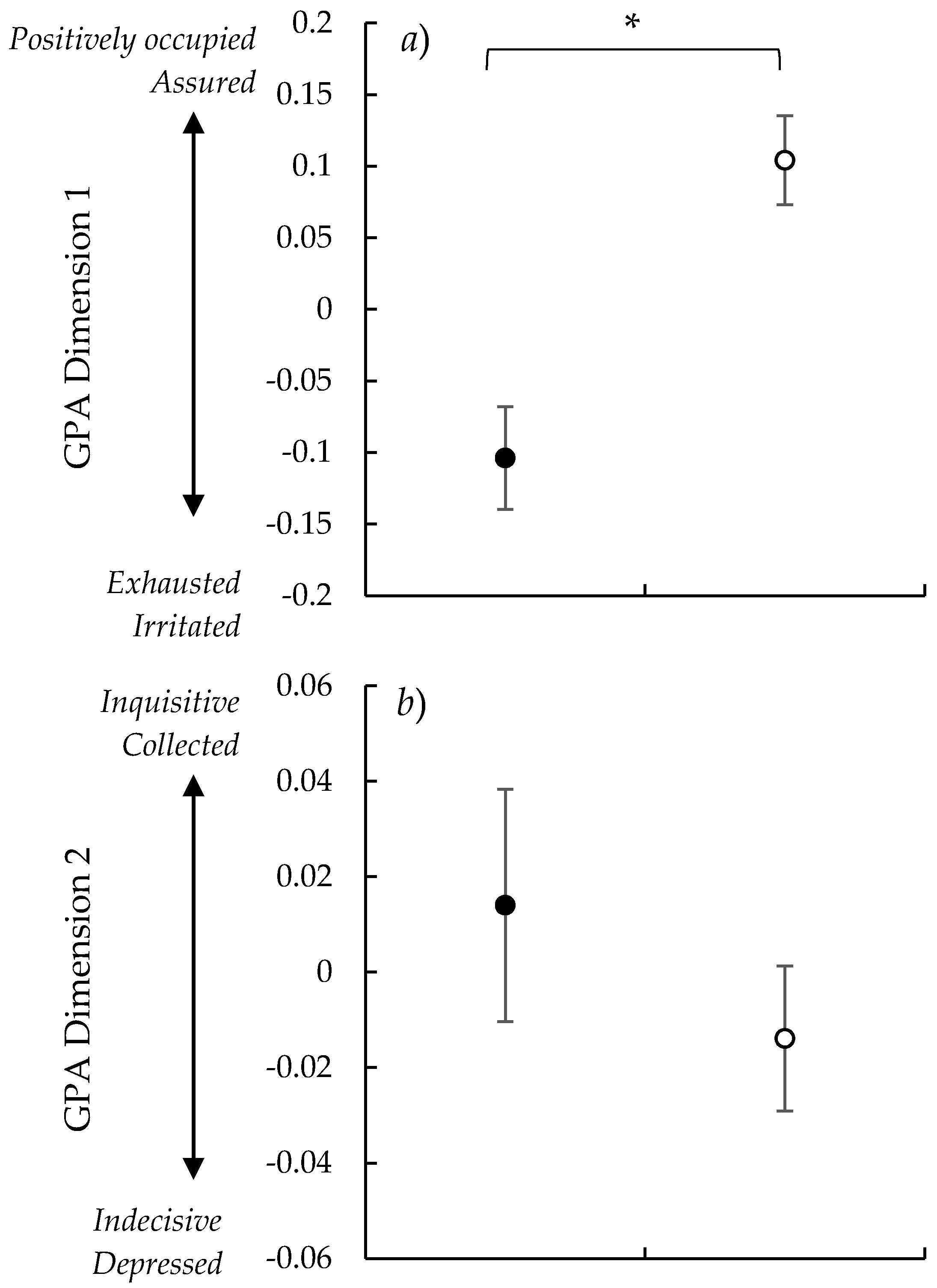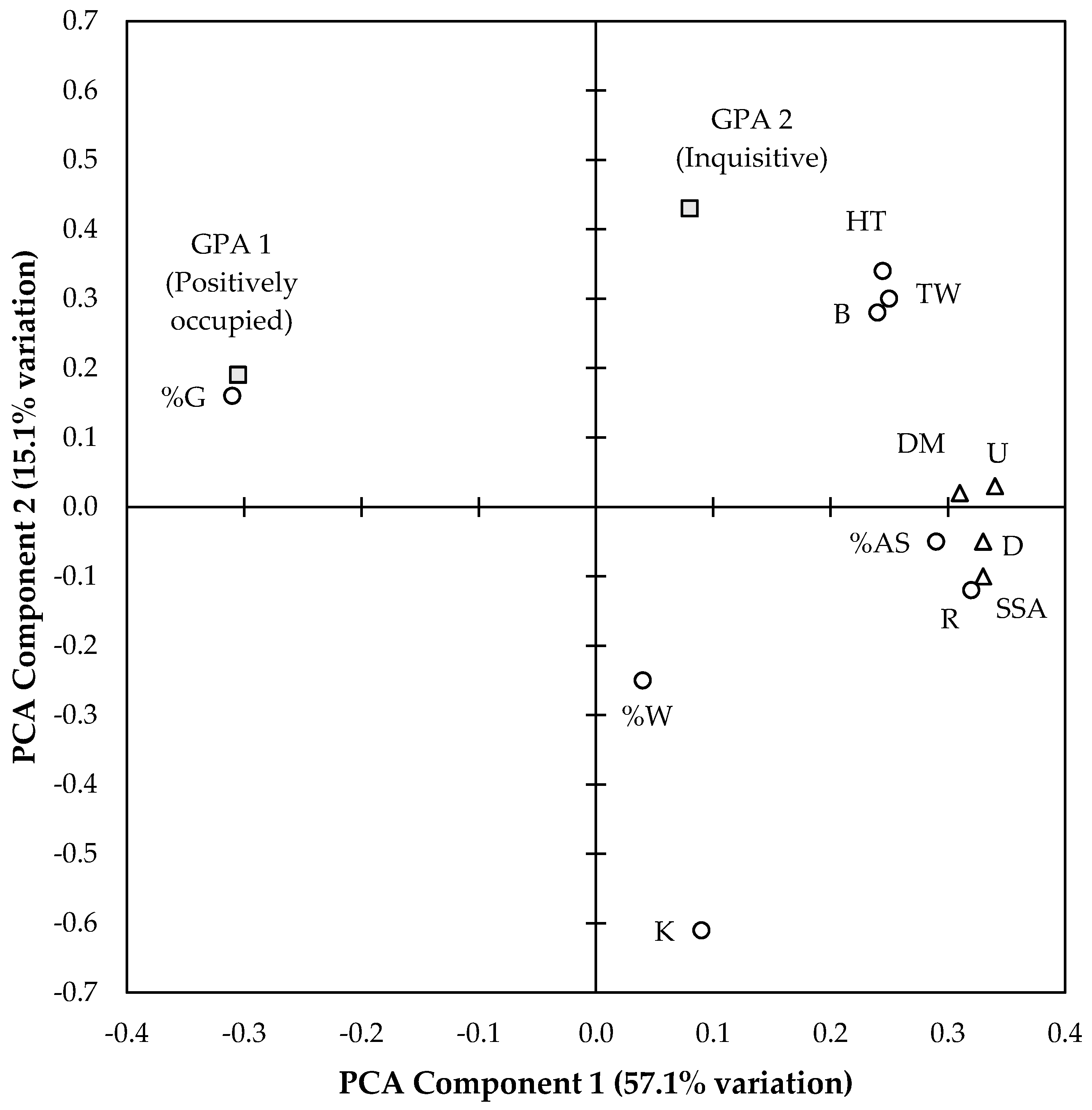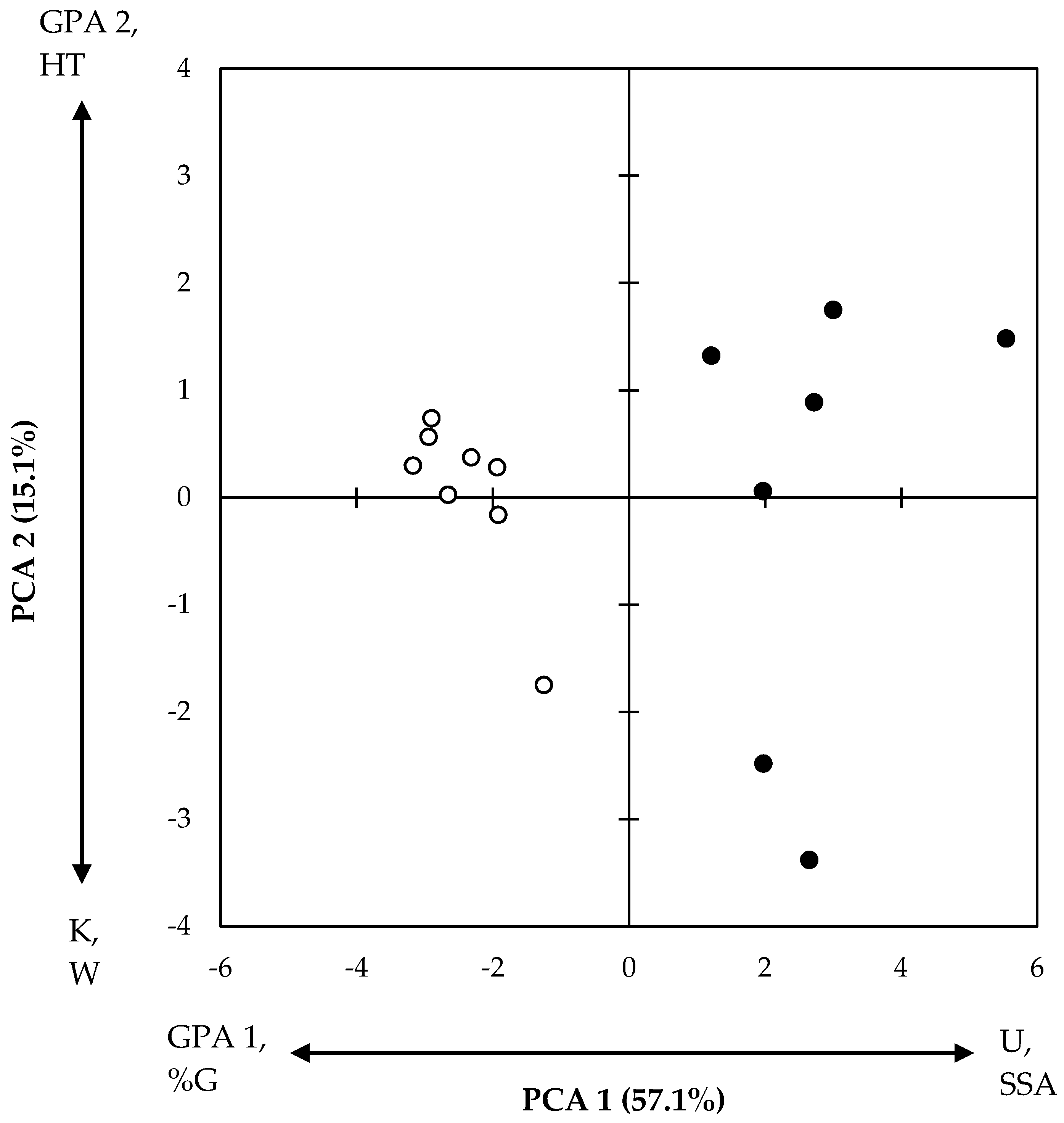Remote Identification of Sheep with Flystrike Using Behavioural Observations
Abstract
:Simple Summary
Abstract
1. Introduction
2. Materials and Methods
2.1. Animals and Experimental Design
2.2. Breech Soiling Assessment
2.3. Behaviour
2.3.1. Quantitative Behaviour Scoring
2.3.2. Qualitative Behavioural Assessment (QBA)
Session 1—Term Generation and Training
Session 2—Quantification
2.4. Statistical Analysis
2.4.1. Quantitative Behaviour Scoring
2.4.2. Qualitative Behavioural Assessment (QBA) Analysis
2.4.3. Associations between Breech Soiling Assessments, Behaviour Scoring, and QBA
3. Results
3.1. Breech Soiling Assessment
3.2. Quantitatve Behaviour Scoring
3.3. Qualitative Behavioural Assessment (QBA)
3.4. Association between QBA, Behavioural and Breech Soiling Parameters
4. Discussion
4.1. General Quantitative Behavioural Responses of Sheep to Breech Flystrike
4.2. Associations between Breech Soiling Assessments, Behavioural Scoring and QBA
4.3. Qualitative Behaivoural Assessment (QBA)
4.4. Considerations for Practical Application
4.5. Limitations and Future Work
5. Conclusions
Author Contributions
Funding
Acknowledgments
Conflicts of Interest
References
- Wall, R. Ovine cutaneous myiasis: Effects on production and control. Vet. Parasitol. 2012, 189, 44–51. [Google Scholar] [CrossRef] [PubMed]
- Anstead, C.A.; Perry, T.; Richards, S.; Korhonen, P.K.; Young, N.D.; Bowles, V.M.; Batterham, P.; Gasser, R.B. Chapter Five—The Battle Against Flystrike—Past Research and New Prospects Through Genomics. In Advances in Parasitology; Rollinson, D., Stothard, J.R., Eds.; Academic Press: Cambridge, MA, USA, 2017; Volume 98, pp. 227–281. [Google Scholar]
- Tellam, R.L.; Bowles, V.M. Control of blowfly strike in sheep: Current strategies and future prospects. Int. J. Parasitol. 1997, 27, 261–273. [Google Scholar] [CrossRef]
- Mauldin, E.A.; Peters-Kennedy, J. Chapter 6—Integumentary System. In Jubb, Kennedy & Palmer’s Pathology of Domestic Animals: Volume 1, 6th ed.; Maxie, M.G., Ed.; W.B. Saunders: Philadelphia, PA, USA, 2016. [Google Scholar]
- Gibson, J.A.; Thomas, R.J.; O’Sullivan, B.M. Pathological consequences of myiasis in sheep. Proc. Aust. Society Anim. Prod. 1984, 15, 178–180. [Google Scholar]
- Horton, B.J.; Corkrey, R.; Doughty, A.K. Sheep death and loss of production associated with flystrike in mature Merino and crossbred ewes. Anim. Prod. Sci. 2018, 58, 1289. [Google Scholar] [CrossRef]
- Plant, J.W. Sheep ectoparasite control and animal welfare. Small Rumin. Res. 2006, 62, 109–112. [Google Scholar] [CrossRef]
- Broadmeadow, M.; Connell, J.A.; O’Sullivan, B.M. Fever after larval challenge. Proc. Aust. Society Anim. Prod. 1984, 15, 173–175. [Google Scholar]
- Wardhaugh, K.; Morton, R. The incidence of flystrike in sheep in relation to weather conditions, sheep husbandry, and the abundance of the Australian sheep blowfly, Lucilia cuprina (Wiedemann) (Diptera: Calliphoridae). Aust. J. Agric. Res. 1990, 41, 1155–1167. [Google Scholar] [CrossRef]
- Phillips, C. A review of mulesing and other methods to control flystrike (cutaneous myiasis) in sheep. Anim. Welf. 2009, 18, 113–121. [Google Scholar]
- Sandeman, R.M.; Levot, G.W.; Heath, A.C.G.; James, P.J.; Greeff, J.C.; Scott, M.J.; Batterham, P.; Bowles, V.M. Control of the sheep blowfly in Australia and New Zealand—Are we there yet? Int. J. Parasitol. 2014, 44, 879–891. [Google Scholar] [CrossRef]
- Wardhaugh, K.G.; Morton, R.; Bedo, D.; Horton, B.J.; Mahon, R.J. Estimating the incidence of fly myiases in Australian sheep flocks: Development of a weather-driven regression model. Med. Vet. Entomol. 2007, 21, 153–167. [Google Scholar] [CrossRef]
- Dawkins, M.S. Using behaviour to assess animal welfare. Anim. Welf. 2004, 13, S3–S7. [Google Scholar]
- Gougoulis, D.A.; Kyriazakis, I.; Fthenakis, G.C. Diagnostic significance of behaviour changes of sheep: A selected review. Small Rumin. Res. 2010, 92, 52–56. [Google Scholar] [CrossRef]
- Anderson, P.J.; Shipp, E.; Anderson, J.M.E.; Dobbie, W. Population Maintenance of Lucilia-Cuprina (Wiedemann) in the Arid Zone. Aust. J. Zool. 1988, 36, 241–249. [Google Scholar] [CrossRef]
- Wemelsfelder, F.; Hunter, T.E.A.; Mendl, M.T.; Lawrence, A.B. Assessing the ‘whole animal’: a free choice profiling approach. Anim. Behav. 2001, 62, 209–220. [Google Scholar] [CrossRef]
- Wemelsfelder, F.; Lawrence, A.B. Qualitative Assessment of Animal Behaviour as an On-Farm Welfare-monitoring Tool. Acta. Agric. Scand. A. Anim. Sci. 2001, 51, 21–25. [Google Scholar] [CrossRef]
- Fleming, P.A.; Clarke, T.; Wickham, S.L.; Stockman, C.A.; Barnes, A.L.; Collins, T.; Miller, D.W. The contribution of qualitative behavioural assessment to appraisal of livestock welfare. Anim. Prod. Sci. 2016, 56, 1569–1578. [Google Scholar] [CrossRef]
- AWI. Visual Sheep Scores; Australian Wool Innovation and Meat and Livestock Australia: Sydney, Austrilia, 2007. [Google Scholar]
- Greeff, J.C.; Karlsson, L.J.E.; Schlink, A.C. Identifying indicator traits for breech strike in Merino sheep in a Mediterranean environment. Anim. Prod. Sci. 2014, 54, 125–140. [Google Scholar] [CrossRef] [Green Version]
- Scholtz, A.J.; Cloete, S.W.P.; van Wyk, J.B.; Kruger, A.C.M.; van der Linde, T.C.d.K. Influence of divergent selection for reproduction on the occurrence of breech strike in mature Merino ewes. Anim. Prod. Sci. 2010, 50, 203–209. [Google Scholar] [CrossRef]
- Grant, E.P.; Brown, A.; Wickham, S.L.; Anderson, F.; Barnes, A.L.; Fleming, P.A.; Miller, D.W. What can the quantitative and qualitative behavioural assessment of videos of sheep moving through an autonomous data capture system tell us about welfare? Appl. Anim. Behav. Sci. 2018, 208, 31–39. [Google Scholar] [CrossRef]
- National Research Council. Recognition and Alleviation of Pain in Laboratory Animals; National Academies Press: Washington, DC, USA, 2009. [Google Scholar]
- Thornton, P.D.; Waterman-Pearson, A.E. Quantification of the pain and distress responses to castration in young lambs. Res. Vet. Sci. 1999, 66, 107–118. [Google Scholar] [CrossRef]
- Molony, V.; Kent, J.E.; McKendrick, I.J. Validation of a method for assessment of an acute pain in lambs. Appl. Anim. Behav. Sci. 2002, 76, 215–238. [Google Scholar] [CrossRef]
- Lomax, S.; Dickson, H.; Sheil, M.; Windsor, P.A. Topical anaesthesia alleviates short-term pain of castration and tail docking in lambs. Aust. Vet. J. 2010, 88, 67–74. [Google Scholar] [CrossRef] [PubMed]
- Grant, C. Behavioural responses of lambs to common painful husbandry procedures. Appl. Anim. Behav. Sci. 2004, 87, 255–273. [Google Scholar] [CrossRef]
- Fell, L.R.; Shutt, D.A. Behavioural and hormonal responses to acute surgical stress in sheep. Appl. Anim. Behav. Sci. 1989, 22, 283–294. [Google Scholar] [CrossRef]
- Broom, D.M. Behaviour and welfare in relation to pathology. Appl. Anim. Behav. Sci. 2006, 97, 73–83. [Google Scholar] [CrossRef]
- Colditz, I.G. Effects of the immune system on metabolism: Implications for production and disease resistance in livestock. Livest. Sci. 2002, 75, 257–268. [Google Scholar] [CrossRef]
- Hart, B.L. Biological basis of the behavior of sick animals. Neurosci. Biobehav. Rev. 1988, 12, 123–137. [Google Scholar] [CrossRef]
- Camerlink, I.; Peijnenburg, M.; Wemelsfelder, F.; Turner, S.P. Emotions after victory or defeat assessed through qualitative behavioural assessment, skin lesions and blood parameters in pigs. Appl. Anim. Behav. Sci. 2016, 183, 28–34. [Google Scholar] [CrossRef]
- de Boyer des Roches, A.; Lussert, A.; Faure, M.; Herry, V.; Rainard, P.; Durand, D.; Wemelsfelder, F.; Foucras, G. Dairy cows under experimentally-induced Escherichia coli mastitis show negative emotional states assessed through Qualitative Behaviour Assessment. Appl. Anim. Behav. Sci. 2018, 206, 1–11. [Google Scholar] [CrossRef]
- Phythian, C.J.; Michalopoulou, E.; Cripps, P.J.; Duncan, J.S.; Wemelsfelder, F. On-farm qualitative behaviour assessment in sheep: Repeated measurements across time, and association with physical indicators of flock health and welfare. Appl. Anim. Behav. Sci. 2016, 175, 23–31. [Google Scholar] [CrossRef]
- Boissy, A.; Manteuffel, G.; Jensen, M.B.; Moe, R.O.; Spruijt, B.; Keeling, L.J.; Winckler, C.; Forkman, B.; Dimitrov, I.; Langbein, J.; et al. Assessment of positive emotions in animals to improve their welfare. Physiol. Behav. 2007, 92, 375–397. [Google Scholar] [CrossRef] [PubMed]
- Rutherford, K.M.; Donald, R.D.; Lawrence, A.B.; Wemelsfelder, F. Qualitative Behavioural Assessment of emotionality in pigs. Appl. Anim. Behav. Sci. 2012, 139, 218–224. [Google Scholar] [CrossRef] [PubMed] [Green Version]
- Hintze, S.; Murphy, E.; Bachmann, I.; Wemelsfelder, F.; Würbel, H. Qualitative Behaviour Assessment of horses exposed to short-term emotional treatments. Appl. Anim. Behav. Sci. 2017, 196, 44–51. [Google Scholar] [CrossRef]
- Minero, M.; Dalla Costa, E.; Dai, F.; Canali, E.; Barbieri, S.; Zanella, A.; Pascuzzo, R.; Wemelsfelder, F. Using qualitative behaviour assessment (QBA) to explore the emotional state of horses and its association with human-animal relationship. Appl. Anim. Behav. Sci. 2018, 204, 53–59. [Google Scholar] [CrossRef]
- Knierim, U.; Winckler, C. On-farm welfare assessment in cattle: Validity, reliability and feasibility issues and future perspectives with special regard to the welfare quality(R) approach. Anim. Welf. 2009, 18, 451–458. [Google Scholar]
- Matthews, S.G.; Miller, A.L.; Clapp, J.; Plötz, T.; Kyriazakis, I. Early detection of health and welfare compromises through automated detection of behavioural changes in pigs. Vet. J. 2016, 217, 43–51. [Google Scholar] [CrossRef] [PubMed] [Green Version]
- Rutten, C.J.; Velthuis, A.G.J.; Steeneveld, W.; Hogeveen, H. Invited review: Sensors to support health management on dairy farms. J. Dairy Sci. 2013, 96, 1928–1952. [Google Scholar] [CrossRef]
- Fogarty, E.S.; Swain, D.L.; Cronin, G.; Trotter, M. Autonomous on-animal sensors in sheep research: A systematic review. Comput. Electron. Agric. 2018, 150, 245–256. [Google Scholar] [CrossRef]
- Williams, L.R.; Bishop-Hurley, G.J.; Anderson, A.E.; Swain, D.L. Application of accelerometers to record drinking behaviour of beef cattle. Anim. Prod Sci. 2018. [Google Scholar] [CrossRef]
- Gigliuto, C.; De Gregori, M.; Malafoglia, V.; Raffaeli, W.; Compagnone, C.; Visai, L.; Petrini, P.; Avanzini, M.A.; Muscoli, C.; Viganò, J.; et al. Pain assessment in animal models: Do we need further studies? J. Pain Res. 2014, 7, 227–236. [Google Scholar] [CrossRef]
- Landa, L. Pain in domestic animals and how to assess it: A review. Vet. Med. 2012, 57, 185–192. [Google Scholar] [CrossRef]



| Behaviour | Description |
|---|---|
| (a) Abnormal behaviour (count of sheep per treatment group showing each of these activities at least once over the clip duration) | |
| Kicking | Either front or hind limb was raised and forcefully strikes the ground or is moved backwards or forwards without moving other limbs. |
| Tail wagging | Rapid and repetitive side-to-side tail movements separated from another tail wagging event by at least 2 sec. |
| Head turning | Turning head beyond the shoulder. |
| Biting rump region | Turing head beyond the shoulder and sheep actively biting rump area. |
| (b) Score of ‘restlessness’ | |
| Restlessness | The number of interruptions or changes to the predominant behaviour (walking, grazing or standing) of the sheep for the combined (abnormal) behaviours of kicking, head shake, head turning, biting rump region and tail wagging. |
| (c) Percentage of time spent (% of total time observed) | |
| Walking | Moving forward in a four beat motion for 2 s or more with head orientated in direction of movement. |
| Grazing | Actively chewing pasture. Head may be lowered towards ground or raised if chewing. |
| Total standing | Standing stationary on four legs, without jaw movement indicative of chewing. Includes normal standing with head and neck in normal or neutral position, and abnormal standing (see below) restricted to when animal was not actively grazing. |
| Abnormal standing | Abnormal head and neck posture when standing stationary includes standing with head lowered (below withers) and hunched back, head orientated towards the side, neck extended and head in low position or head turned towards rump region. Restricted to when animal was not actively grazing. |
| Behavioural Parameters | Kendall W | p-Value |
|---|---|---|
| (a) Abnormal behaviour | ||
| Kicking | 0.77 | 0.003 |
| Tail wagging | 0.84 | <0.001 |
| Head turn | 0.82 | 0.001 |
| Biting rump region | 1.00 | <0.001 |
| (b) Score of ‘restlessness’ | ||
| Restlessness | 0.89 | <0.001 |
| (c) Percentage of time spent | ||
| Walking | 0.94 | <0.001 |
| Grazing | 0.90 | <0.001 |
| Abnormal standing | 0.84 | <0.001 |
| Behavioural Parameters | Raw Value | |
|---|---|---|
| Flystruck (n = 8) | Non-flystruck (n = 8) | |
| (a) Abnormal behaviour (count of sheep per treatment group) | ||
| Kicking | 3 (37.5%) a | 1 (12.5%) b |
| Tail wagging | 5 (62.5%) a | 1 (12.5%) b |
| Head turn | 4 (50.0%) a | 0 (0.0%) b |
| Biting rump region | 5 (62.5%) a | 0 (0.0%) b |
| (b) Score of ‘restlessness’ (no. instances) | ||
| Restlessness | 4.89 ± 0.55 a | 1.25 0.53 b |
| (c) Percentage of time spent (% of total time observed) | ||
| Walking | 0.17 ± 0.08 a | 0.15 ± 0.06 a |
| Grazing | 0.09 ± 0.09 a | 0.74 ± 0.07 b |
| Abnormal standing | 0.73 ± 0.11 a | 0.12 ± 0.07 b |
| GPA Dimension (% of Variation Explained) Kendall’s W | Descriptive Terms † | |
|---|---|---|
| Low Values | High Values | |
| GPA 1 (58.1%) 0.66 *** | Exhausted (1), irritated (8), tense (1), agitated (7), frustrated (4), distressed (8), alarmed (1). | Positively occupied (1), assured (1), unhurried (1), active (1), content (12), relaxed (21), settled (2), happy (18). |
| GPA 2 (9.6%) 0.56 *** | Indecisive (1), depressed (2), afraid (1), insecure (2). | Inquisitive (4), collected (1), dull 1), interested (2), lively (2), aggressive (3), alarmed (1), unhurried (1), joyful (2), settled (2), cautious (8). |
© 2019 by the authors. Licensee MDPI, Basel, Switzerland. This article is an open access article distributed under the terms and conditions of the Creative Commons Attribution (CC BY) license (http://creativecommons.org/licenses/by/4.0/).
Share and Cite
Grant, E.P.; Wickham, S.L.; Anderson, F.; Barnes, A.L.; Fleming, P.A.; Miller, D.W. Remote Identification of Sheep with Flystrike Using Behavioural Observations. Animals 2019, 9, 368. https://doi.org/10.3390/ani9060368
Grant EP, Wickham SL, Anderson F, Barnes AL, Fleming PA, Miller DW. Remote Identification of Sheep with Flystrike Using Behavioural Observations. Animals. 2019; 9(6):368. https://doi.org/10.3390/ani9060368
Chicago/Turabian StyleGrant, Emily P., Sarah L. Wickham, Fiona Anderson, Anne L. Barnes, Patricia A. Fleming, and David W. Miller. 2019. "Remote Identification of Sheep with Flystrike Using Behavioural Observations" Animals 9, no. 6: 368. https://doi.org/10.3390/ani9060368
APA StyleGrant, E. P., Wickham, S. L., Anderson, F., Barnes, A. L., Fleming, P. A., & Miller, D. W. (2019). Remote Identification of Sheep with Flystrike Using Behavioural Observations. Animals, 9(6), 368. https://doi.org/10.3390/ani9060368





